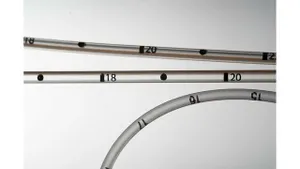Nature's brilliance meets industrial design for improved parts
Processors of reinforced plastic parts long have known that the orientation of the reinforcing fibers is critical to the strength and durability of the final parts. Controlling that orientation presents one problem, but at a more basic level is trying to determine what orientation and mix of reinforcing material is necessary. Researchers from the Fraunhofer Institutes for Mechanics of Materials IWM and for Environmental, Safety and Energy Technology UMSICHT are working to answer this second question.
September 1, 2011

Processors of reinforced plastic parts long have known that the orientation of the reinforcing fibers is critical to the strength and durability of the final parts. Controlling that orientation presents one problem, but at a more basic level is trying to determine what orientation and mix of reinforcing material is necessary. Researchers from the Fraunhofer Institutes for Mechanics of Materials IWM and for Environmental, Safety and Energy Technology UMSICHT are working to answer this second question.
|
The picture on the left shows a lightweight structure made of polyamide inspired by bionic principles. The picture on the right shows its detailed simulation on the computer. (Photo, Fraunhofer IWM) |
Experts from both research organizations are collaborating on a project entitled "Bionic Manufacturing", which aims to develop products that are lightweight but strong and economic in their use of materials - imitating the perfected structures found in nature. The researchers are looking at straw, bamboo, bones, teeth and others to identify how the internal structures and combination of materials in these makes them much stronger than could be expected.
The goal of the research is to identify the best internal structures for manufactured components, such as reinforced plastic parts. "We have set ourselves the challenge of working as efficiently as nature: The finished component must not weigh more than necessary and yet still be able to perform its mechanical function reliably," explains Raimund Jaeger of IWM (Freiburg, Germany). Designing parts with increased strength is one aspect; another is to ensure that, should these bionic ally designed objects break as the result of excessive loading, they will do so in a benign way - collapsing in localized areas rather than shattering into sharp splinters.
To speed its work, the Freiburg research team has developed a new design method. They start by constructing a virtual model of the future workpiece on the computer, filling out its contours with almost identical, cube-shaped, elementary cells. If the numerical simulation reveals that the grid structure does not satisfy requirements, the cell walls are refined accordingly. "We make them thicker if they are too weak and thinner if they need to be more pliable, or align them with the force lines along which the load is distributed," explains Jaeger.
This method enables many different shapes to be designed around an inner cell structure that can then be evaluated and optimized using the simulation tool. To complement the simulations, the researchers carry out tests on real-life components to verify the structure's mechanical properties.
Jaeger reports that the method has worked very well every time they have used it to design any type of workpiece based on two-dimensional templates that can be pulled into the desired shape using the computer simulation. The same applies to components with a relatively regular shape. According to the scientists, they have potential applications wherever there is a need for products that combine a high level of mechanical stability and aesthetic appearance with low weight - for example medical orthopedic devices or anatomically formed body protectors such as lumbar support belts for skiers.
Fraunhofer UMSICHT (Oberhausen, also Germany) is responsible for the technical implementation of the bionic design principles. They are using additive manufacturing techniques such as selective laser sintering to create the parts for testing.
About the Author(s)
You May Also Like



